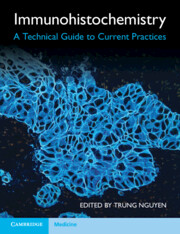Book contents
- Immunohistochemistry
- Immunohistochemistry
- Copyright page
- Dedication
- Contents
- Contributors
- Preface
- Chapter 1 Immunohistochemistry Fundamentals
- Chapter 2 Immunohistochemistry Quality Assurance and Quality Control
- Chapter 3 Automation and Robotics with the Leica Bond III
- Chapter 4 Automation and Robotics with the Roche Ventana BenchMark ULTRA
- Chapter 5 Automation and Robotics with the Agilent Dako Omnis
- Chapter 6 Immunohistochemistry for Research Applications
- Chapter 7 Troubleshooting Immunohistochemistry
- Chapter 8 Current Status of Immunohistochemistry
- Chapter 9 Immunohistochemistry for Future Applications
- Index
- References
Chapter 3 - Automation and Robotics with the Leica Bond III
Published online by Cambridge University Press: 16 June 2022
- Immunohistochemistry
- Immunohistochemistry
- Copyright page
- Dedication
- Contents
- Contributors
- Preface
- Chapter 1 Immunohistochemistry Fundamentals
- Chapter 2 Immunohistochemistry Quality Assurance and Quality Control
- Chapter 3 Automation and Robotics with the Leica Bond III
- Chapter 4 Automation and Robotics with the Roche Ventana BenchMark ULTRA
- Chapter 5 Automation and Robotics with the Agilent Dako Omnis
- Chapter 6 Immunohistochemistry for Research Applications
- Chapter 7 Troubleshooting Immunohistochemistry
- Chapter 8 Current Status of Immunohistochemistry
- Chapter 9 Immunohistochemistry for Future Applications
- Index
- References
Summary
Leica’s current IHC instrument is the Bond III. A review is conducted by a medical scientist using it on a daily basis so that an honest evaluation is afforded from first-hand experience. Topics of interest include the machinery Leica employs for epitope retrieval and the coverplate technology to assist in reagent delivery. A discussion about proprietary reagents and consumables whilst highlighting the various components of the machine is provided. There are tips and tricks offered to get the most out of the platform. Programming stain protocols for both chromogenic, fluorescence and double labelling IHC are specified along with equipment servicing and maintenance requirements. The reader in essence, gets to appreciate what it is really like to operate and work with the Bond III. The chapter concludes with both good and bad aspects of this form of automation and some opportunities for improvement.
Keywords
- Type
- Chapter
- Information
- ImmunohistochemistryA Technical Guide to Current Practices, pp. 67 - 84Publisher: Cambridge University PressPrint publication year: 2022
References
- 1
- Cited by



